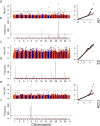A novel iterative mixed model to remap three complex orthopedic traits in dogs
- PMID: 28614352
- PMCID: PMC5470659
- DOI: 10.1371/journal.pone.0176932
A novel iterative mixed model to remap three complex orthopedic traits in dogs
Abstract
Hip dysplasia (HD), elbow dysplasia (ED), and rupture of the cranial (anterior) cruciate ligament (RCCL) are the most common complex orthopedic traits of dogs and all result in debilitating osteoarthritis. We reanalyzed previously reported data: the Norberg angle (a quantitative measure of HD) in 921 dogs, ED in 113 cases and 633 controls, and RCCL in 271 cases and 399 controls and their genotypes at ~185,000 single nucleotide polymorphisms. A novel fixed and random model with a circulating probability unification (FarmCPU) function, with marker-based principal components and a kinship matrix to correct for population stratification, was used. A Bonferroni correction at p<0.01 resulted in a P< 6.96 ×10-8. Six loci were identified; three for HD and three for RCCL. An associated locus at CFA28:34,369,342 for HD was described previously in the same dogs using a conventional mixed model. No loci were identified for RCCL in the previous report but the two loci for ED in the previous report did not reach genome-wide significance using the FarmCPU model. These results were supported by simulation which demonstrated that the FarmCPU held no power advantage over the linear mixed model for the ED sample but provided additional power for the HD and RCCL samples. Candidate genes for HD and RCCL are discussed. When using FarmCPU software, we recommend a resampling test, that a positive control be used to determine the optimum pseudo quantitative trait nucleotide-based covariate structure of the model, and a negative control be used consisting of permutation testing and the identical resampling test as for the non-permuted phenotypes.
Conflict of interest statement
Figures


References
-
- Olin J. Orthopedic Foundation for Animals Columbia, Missouri2016 [Available from: www.ofa.org.
-
- Verhoeven G, Fortrie R, Van Ryssen B, Coopman F. Worldwide screening for canine hip dysplasia: where are we now? Veterinary surgery: VS. 2012;41(1):10–9. - PubMed
-
- Hou Y, Wang Y, Lu X, Zhang X, Zhao Q, Todhunter RJ, et al. Monitoring hip and elbow dysplasia achieved modest genetic improvement of 74 dog breeds over 40 years in USA. PloS one. 2013;8(10):e76390 doi: 10.1371/journal.pone.0076390 - DOI - PMC - PubMed
-
- Breur GJ LN, Todhunter RT. Genetics of Orthopedic Traits. The Genetics of the dog. Ruvinsky A OE, editor. Wallingford, Oxon, UK: CAB International; 2012.
-
- Loder RT, Shafer C. The demographics of developmental hip dysplasia in the Midwestern United States (Indiana). J Child Orthop. 2015;9(1):93–8. doi: 10.1007/s11832-015-0636-1 - DOI - PMC - PubMed
MeSH terms
Grants and funding
LinkOut - more resources
Full Text Sources
Other Literature Sources
Medical

